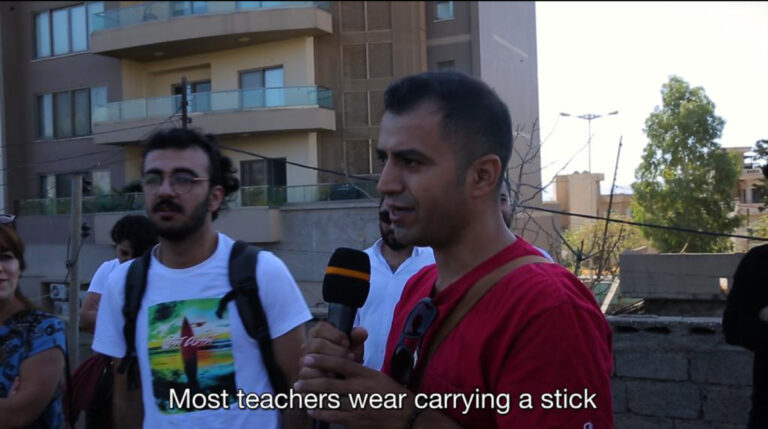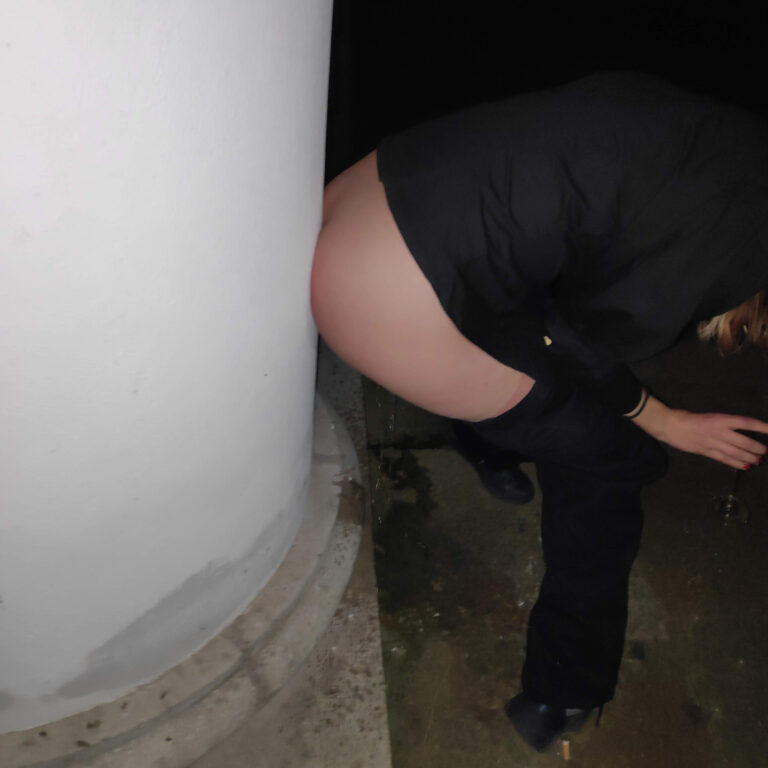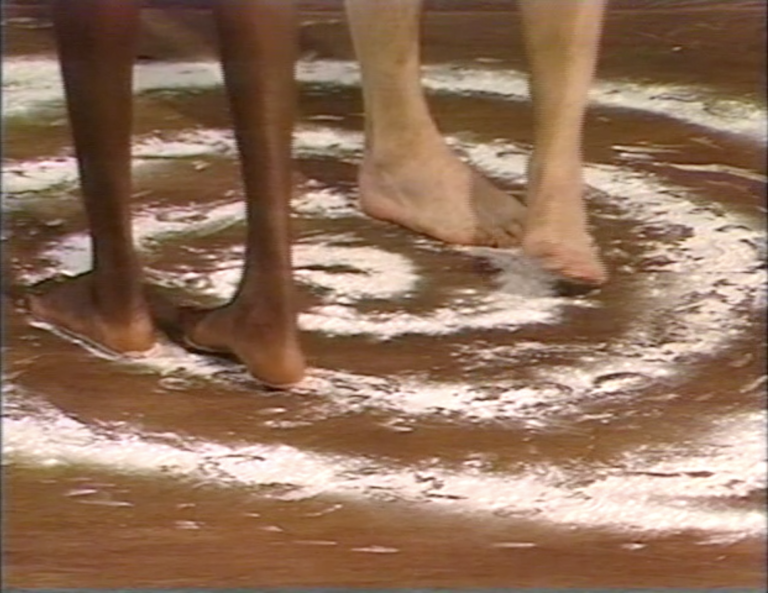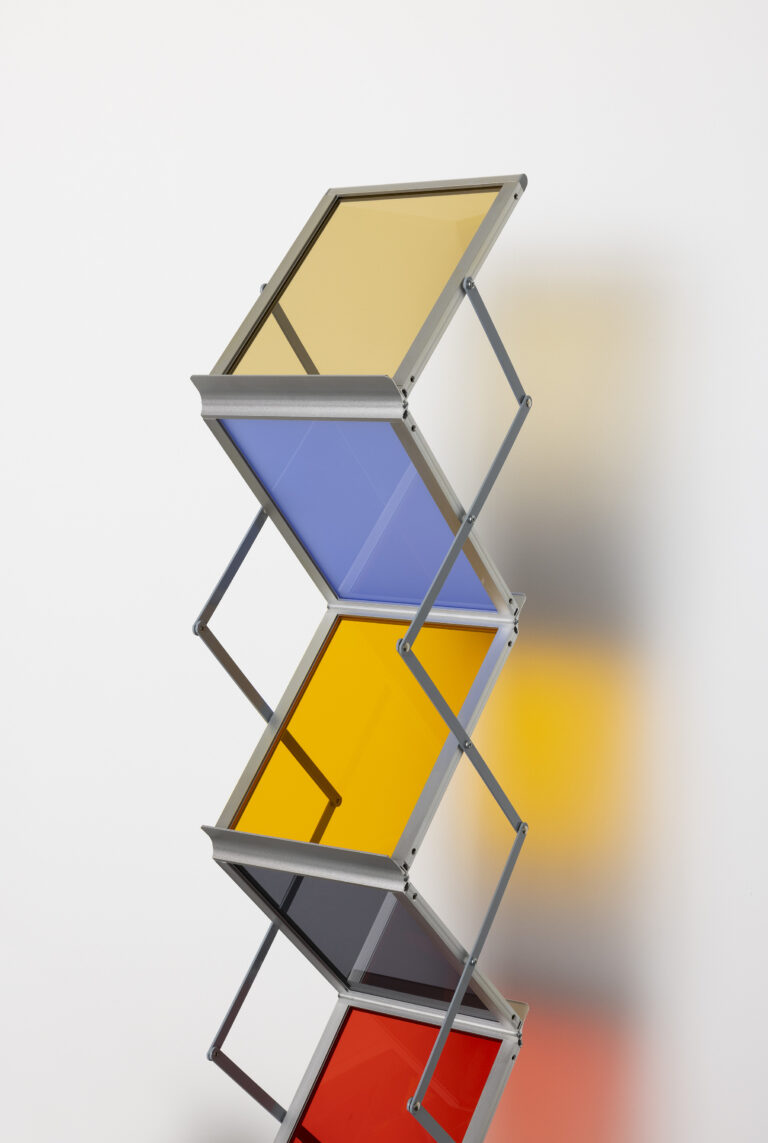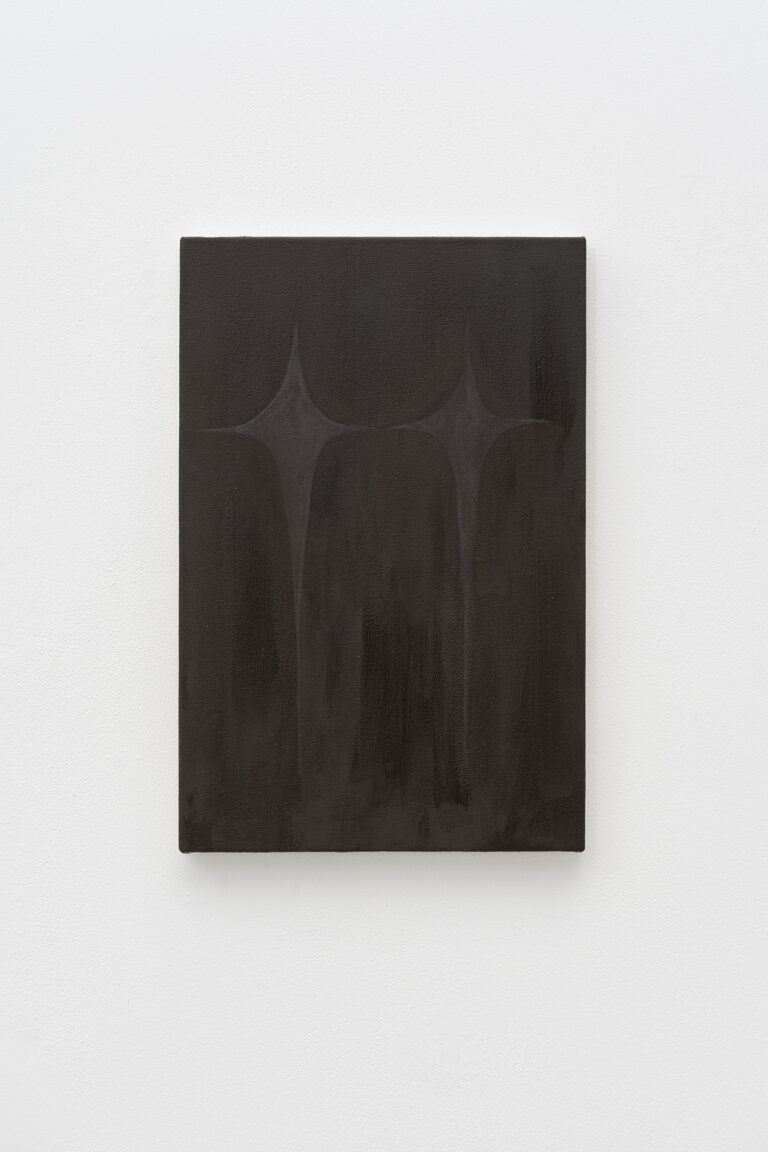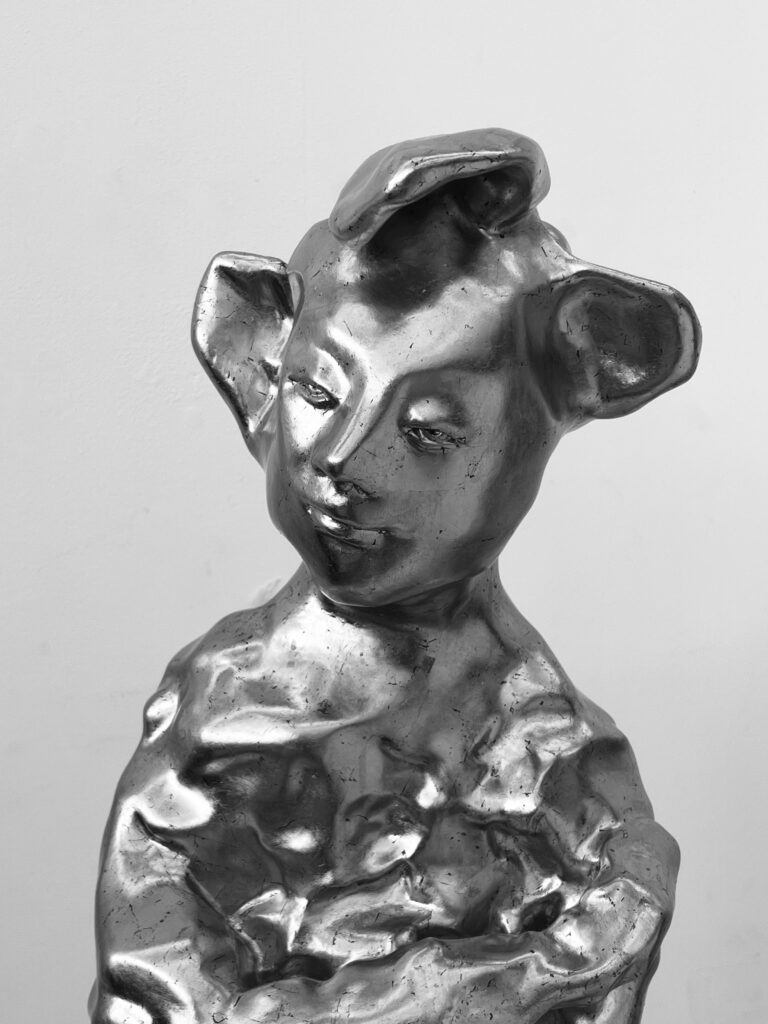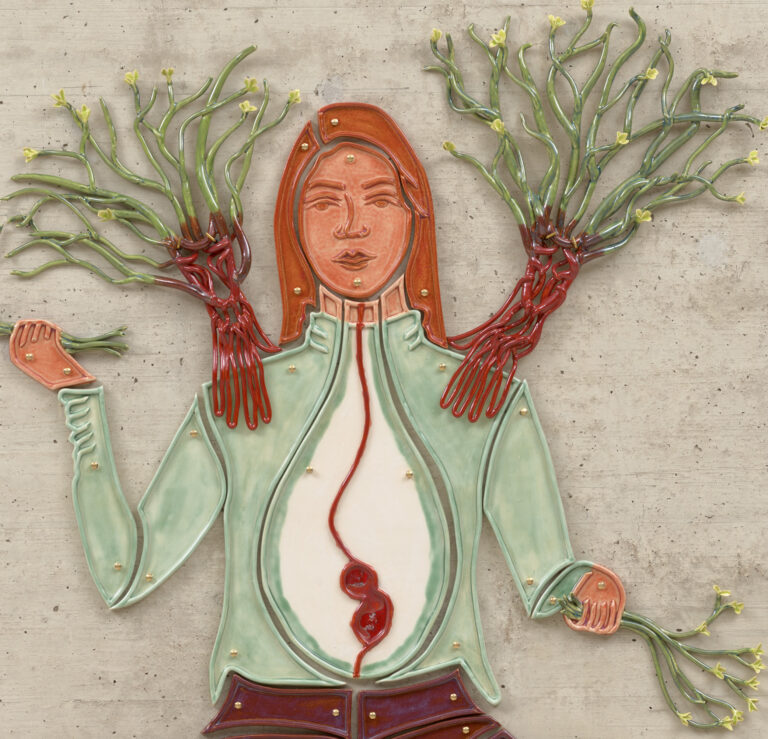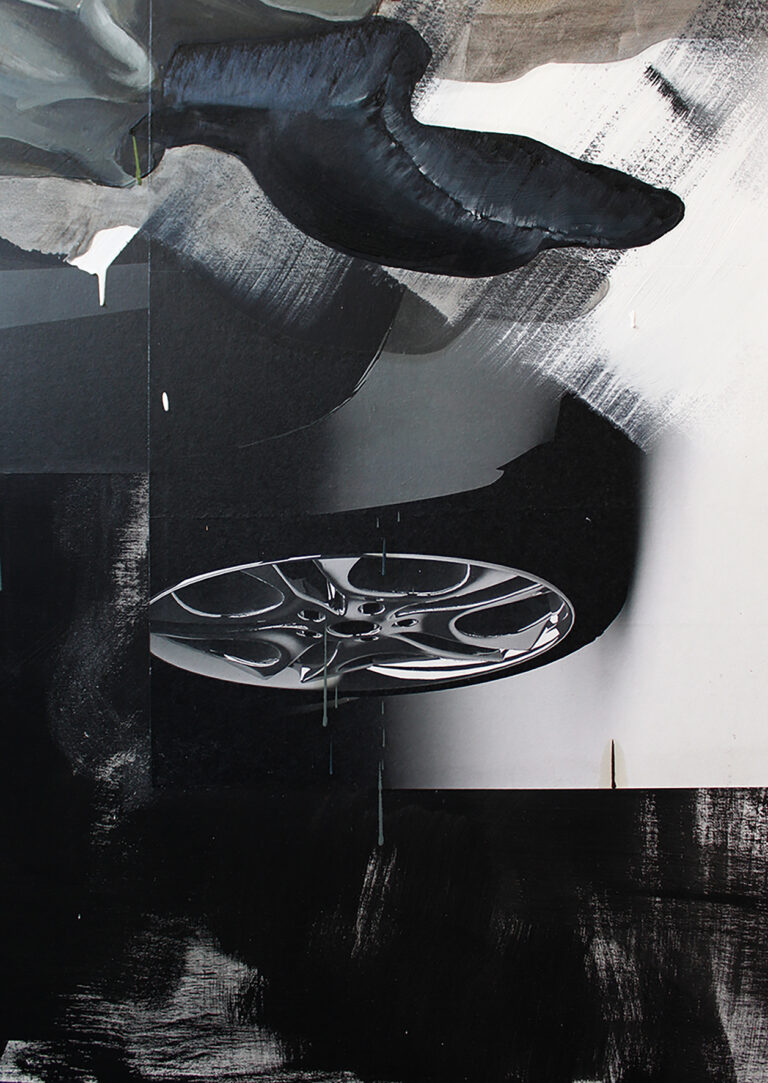Gallery Tour
Mitte Süd
by Kito Nedo, 2023
English Version
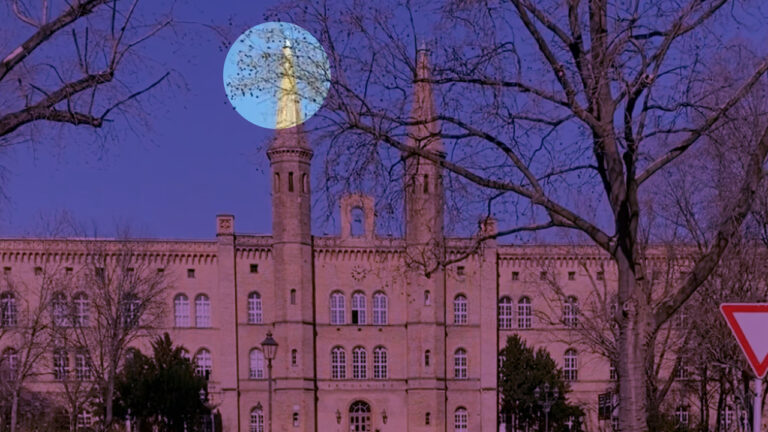
Memory is one of the main threads running through Hiwa K’s work which always takes the viewer on journeys steeped in storytelling. Born in 1975 in the Kurdish-Iraqi city of Sulaymaniyah, the artist participated in Documenta 14 in both Athens and Kassel. With his current video trilogy Like a Good, Good, Good Boy—on view at KOW in Lindenstraße—the Berlin-based artist returns to his birthplace in Iraq. Through his lens, he takes us to his dilapidated family home, his former school and Saddam’s notorious torture prison Amna Suraka, where countless people were tortured and killed in the eighties.
At Nordenhake, the painter Sophie Reinhold (b. 1981, Berlin, Germany) presents paintings and installations in her exhibition titled Dream on. Through elaborate processes using bitumen, marble flour and graphite powder, the artist creates poetic, subtle and often downright polished paintings. However, unlike the show’s title suggests, Reinhold is not concerned with escapism. On the contrary: everything she creates revolves around the dialectic, investigating the truth of opinions by dreaming up various circumstances and instances of artistic-utopian dreaming.
Barbara Thumm is showing a double exhibition: On one hand we find Maria Magdalena Campos-Pons (b. 1959, Matanzas, Cuba) who produces photographs, drawings, videos, performances and installations. The artist who now lives and works in Nashville, Tennessee, delves into topics of Afro-Cuban culture and the diaspora experience. On the other hand, painter Kaloki Nyamai (b. 1985, Kitui, Kenya), who lives and works in Nairobi, brings figurative scenes to canvases prepared with wicker, rope, collage and yarn. Last year, the artist represented Kenya at the Venice Biennale.
Light is a central material in Lucia Koch’s (b. 1966, Porto Alegre, Brazil) artistic practice. The artist, who participated in the 2011 Lyon Art Biennale curated by Okwui Enwezor, often works with subtle and temporary interventions that focus on ceilings, windows, and other architectural openings. For Light Falls, her first solo exhibition at Carlier Gebauer, Koch has developed a site-specific installation.
British painter Jason Martin (b. 1970, Channel Islands, UK) uses an impasto technique to bring colors to his canvases. The color spectrum of these sublime paintings ranges from anthracite and black to striking shades of yellow, blue and red. The exhibition spaces of the Buchmann Gallery pulsate and vibrate with abundant color. The artist, who studied art in London and took part in the iconic show Sensation: Young British Artist in 1997, has always tested the possibilities and limits of the medium. In this respect, Martin often uses a variety of supporting elements in his work such as aluminum, stainless steel and Plexiglas.
Marina Adams draws from sources such as nature, music and poetry. At Thomas Schulte, the internationally lauded painter is showing her exhibition Mother Tongue. Adams is known for her powerful, large-scale paintings depicting abstract combinations of geometric and biomorphic forms. “The role of art in society is to open the doors of the mind and make people breathe,” says Adams, who will also occupy the large gallery window on the busy Leipziger Strasse. “Breathing is key to life, and great art has great breath”.
“We looked for eyes creased with concern, but saw only veils” goes the title of a new exhibition by artist and poet Rhea Dillon (b. 1996, London, UK) at Sweetwater. Dillon works with film, photography, installation and scent. “Free from the constraints of a singular discipline, my work explores and expands on representations of blackness and their relation to queer and feminist theory, all of which are relevant to my personal existence,” says the artist. Her art critically examines discriminatory patterns of representation and searches for alternative visual languages within the context of decolonization.
Peculiar figures populate the artistic universe of sculptor and draftswoman Paloma Varga Weisz. At the Konrad Fischer Gallery, the artist shows mythological-looking animal and human creatures that remind us that horror is an inextricable part of the supposedly rational present. Make no mistake: the sculptor does not exclude herself from her work’s ruthlessness. At the Venice Biennale in 2005 she staged herself as an executed woman for her piece “The Galgenfeld.” Also on show concurrently, an exhibition of works by the Dutch-Surinamese conceptual artist stanley brouwn (1935-2017).
The artist Renaud Regnery (b. 1976) once declared that he did not consider himself a political painter. “But ultimately every gesture is political. When I say that I break orders, I also mean it politically. And metaphorically, that’s what I do all the time.” At Klemm’s, the Berlin-based Frenchman is showing new, large-format paintings under the title What Power Art Thou? which not only address the hybridity of our visual present, but also radicalize it in the form of an artistic gesture.
Right next door at Soy Capitán artist Paloma Proudfoot (b. 1992, London, UK) draws on the medieval moral story “The Three Living and The Three Dead.” As the tale goes, three nobles encounter three talking corpses in the forest. The decaying bodies teach the living that wealth and status in this world become meaningless without redemption in the afterlife. However, the artist doesn’t really care for the story’s didacticism. What her wall frieze of colorfully glazed ceramics is truly interested in is the multi-faceted nature of the endless dialogue between life and death.
Melons are something of a leitmotif in the oeuvre of the artist group Slavs and Tatars. They come in many different varieties, their flesh is sweet and juicy, their scent is enticing, and their surfaces reveal interesting patterns. In new glass and mirror works, on view at Kraupa-Tuskany Zeidler, Slavs and Tatars explore, among other things, the role of the melon as a storehouse of knowledge, a carrier of writing and an economic resource. Part of the concept is influenced by an Uzbek myth that traces the melon’s origin in the Garden of Eden.
The artist Frieda Toranzo Jaeger also traces the connection between ancient myths and utopian discourses in the neighboring Barbara Weiss gallery showing the exhibition Heart Core. Among other things, you’ll find a new large-format canvas titled End of Capitalism, The Fountain (2022) which references the famed 500-year-old triptych The Garden of Earthly Delights by the Dutch master Hieronymus Bosch. As she mentions, the Mexico City-based artist often sees her work as “semiological vandalism.” She goes on: “Painting is often not seen as a political instrument, but dismissed as a commodity.” Holding on to the explosive power of the medium is an essential part of her art.
Gallery Tour
Mitte-Süd
von Kito Nedo, 2023
Deutsche Version
Erinnerung ist eines der großen Themen im Werk von Hiwa K. Der 1975 in der kurdisch-irakischen Stadt Sulaimaniyya geborene Künstler ist ein großer Geschichtenerzähler. 2017 nahm Hiwa K. an der Documenta 14 in Athen und Kassel teil. Mit seiner aktuellen Video-Trilogie Like a Good, Good, Good Boy, zu sehen bei KOW in der Lindenstraße, kehrt der in Berlin lebende Künstler an seinen Geburtsort im Irak zurück. Ins Bild rücken das alte Elternhaus, das heute eine Ruine ist, die ehemalige Schule und Saddams berüchtigtes Foltergefängnis Amna Suraka, in dem in den Achtzigern unzählige Menschen gefoltert und getötet wurden.
In der Galerie Nordenhake hat die 1981 in Berlin geborene Malerin Sophie Reinhold eine Schau mit Gemälden und Installationen eingerichtet. Der Ausstellungstitel: Träum weiter. Doch Reinhold, die in aufwändigen Arbeitsprozessen Materialen wie Bitumen, Marmor-Mehl und Graphitpulver zu poetischen, subtilen und teilweise regelrecht geschliffenen Gemälden verarbeitet, geht es nicht um Eskapismus. Im Gegenteil: Hier dreht sich alles um das dialektische, zupackende Träumen von anderen Verhältnissen und künstlerisch-utopisches Denken.
Bei Barbara Thumm wird eine Doppelschau gezeigt: Maria Magdalena Campos-Pons, die 1959 im kubanischen Matanzas geboren wurde, produziert Fotografien, Zeichnungen, Videos, Performances und Installationen. Im Werk der Künstlerin die heute in Nashville, Tennessee lebt und arbeitet spielen die afrokubanische Kultur und die Erfahrung der Diaspora eine Rolle. Der Maler Kaloki Nyamai, geboren 1985 in Kitui, Kenya, lebt und arbeitet in Nairobi. Nyamai bringt figurative Szenen auf Leinwände, die mit Flechtwerk, Seilen, Collagen und Garn präpariert sind. Im vergangenen Jahr war er Teil des kenianischen Länderbeitrags auf der Venedig Biennale.
In Lucia Kochs künstlerischer Praxis ist Licht ein zentrales Material. Die aus Brasilien stammende Künstlerin, geboren 1966 in Porto Alegre, arbeitet oft mit subtilen und temporären Interventionen, die sich auf Decken, Fenster und andere architektonische Öffnungen konzentrieren. Für Light Falls, ihre erste Einzelausstellung bei Carlier Gebauer hat Koch, die unter anderem Teilnehmerin der 2011 von Okwui Enwezor kuratierten Kunstbiennale in Lyon war, eine ortsspezifische Installation entwickelt.
Das Farbspektrum der erhabenen Bilder von Jason Martin reicht von Anthrazit und Schwarz bis hin zu kräftigen Gelb-, Blau- und Rottönen. So bringt er die Ausstellungsräume der Buchmann Galerie zum Schwingen. Der 1970 auf der Kanalinsel Jersey geborene Künstler, der einst in London Kunst studierte und 1997 an der legendären Schau „Sensation: Young British Artist“ teilnahm, testet seit jeher die Möglichkeiten und Grenzen des Mediums. Martin nutzt etwa verschiedene Farbträger wie Aluminium-, Edelstahl- oder Plexiglasflächen.
Natur, Musik und Poesie sind die Quellen, aus denen Marina Adams für ihre Kunst schöpft. Mother Tongue—„Muttersprache“ heißt die Ausstellung der international gefeierten Malerin in der Galerie Thomas Schulte. Adams ist bekannt für ihre kraftvollen, großformatigen Gemälde mit abstrakten Kombinationen geometrischer und biomorpher Formen. „Die Rolle der Kunst in der Gesellschaft besteht darin, die Türen des Geistes zu öffnen und die Menschen zum Atmen zu bringen“ sagt Adams, die auch das große Galerieschaufenster an der Leipziger Straße bespielen wird. „Atmen ist ein Schlüssel zum Leben, und große Kunst hat einen großen Atem.”
We looked for eyes creased with concern, but saw only veils lautet der Austellungstitel der 1996 in London geborenen Künstlerin und Dichterin Rhea Dillon, die ihre Arbeiten bei Sweetwater zeigt. Dillon arbeitet mit Film, Fotografie, Installationen und Düften. „Frei von den Zwängen einer einzelnen Disziplin untersucht und erweitert meine Arbeit Darstellungen von Schwarzsein und deren Beziehung zu queerem Gedankengut und feministischer Theorie, die alle für meine persönliche Existenz von Bedeutung sind“, sagt die Künstlerin, deren Kunst sich kritisch mit diskriminierenden Repräsentationsmustern auseinandersetzt und im Sinne einer Dekolonialisierung nach anderen Bildsprachen sucht.
Eigentümliche Figuren bevölkern das künstlerische Universum der Bildhauerin und Zeichnerin Paloma Varga Weisz. In der Konrad Fischer Galerie zeigt die Künstlerin mythologisch anmutende Tier- und Menschenwesen, die daran erinnern, dass auch Horror Teil der angeblich so rationellen Gegenwart ist. Von der Schonungslosigkeit nimmt sich die Bildhauerin selbst nicht aus: auf der Venedig-Biennale 2005 präsentierte sie ihre Arbeit Das Galgenfeld in der sie sich selbst als Hingerichtete inszenierte. Parallel wird auch eine Ausstellung mit Arbeiten des niederländisch-surinamischen Konzeptkünstlers stanley brouwn (1935–2017) gezeigt.
Er halte sich selbst nicht für einen für einen politischen Maler hat der Künstler Renaud Regnery einmal erklärt. „Aber letztlich ist jede Geste politisch. Wenn ich sage, dass ich Ordnungen durchbreche, ist das auch politisch gemeint. Und metaphorisch gesehen, ist es das, was ich die ganze Zeit ständig tue.“ Bei Klemm’s zeigt der 1976 geborene, in Berlin lebende Franzose unter dem Titel What Power Art Thou? neue, großformatige Gemälde, die den hybriden Charakter unserer visuellen Gegenwart nicht nur aufgreifen, sondern in Form einer künstlerischen Geste radikalisieren.
Direkt nebenan, bei Soy Capitán greift die 1992 in London geborene Künstlerin Paloma Proudfoot für ihre Ausstellung The Three Living and The Three Dead auf die gleichnamige mittelalterliche Moralgeschichte von den drei Lebenden und den drei Toten zurück. In der Legende treffen drei Adlige im Wald auf drei sprechende Leichname. Die verwesenden Körper belehren die Lebenden, dass Wohlstand und Status im Diesseits ohne Erlösung im Jenseits bedeutungslos werden. Nicht aber der Zeigefinger interessiert die Künstlerin für ihren Wandfries aus farbig glasierten Keramik-Elementen, sondern der Facettenreichtum im sich ewig fortsetzenden Zwiegespräch zwischen Leben und Tod.
Melonen sind so etwas wie ein Leitmotiv im Gesamtwerk der Künstler:innengruppe Slavs and Tatars. Es gibt sie in vielen verschiedenen Sorten, ihr Fruchtfleisch ist süß und saftig, ihr Duft ist verlockend, die Oberflächen weisen interessante Muster auf. In neuen Glas- und Spiegelarbeiten, zu sehen bei Kraupa-Tuskany Zeidler, beschäftigen sich Slavs and Tatars unter anderem mit der Rolle der Melone als Wissensspeicher, Schriftträger und ökonomischer Ressource. Auch der usbekische Mythos, der den Ursprung der Melone im Garten Eden verortet, spielt eine Rolle.
Der Verbindung von alten Mythen und utopischer Diskurse spürt auch die Künstlerin Frieda Toranzo Jaeger in der Nachbar-Galerie Barbara Weiss unter dem Ausstellungstitel „Heart Core“ nach. Zu sehen ist hier unter anderem eine neue großformatige Leinwand mit dem Titel End of Capitalism, The Fountain von 2022. Toranzo Jaeger bezieht sich damit auf das über fünfhundert Jahre alte Triptychon Der Garten der Lüste des niederländischen Meisters Hieronymus Bosch. Sie verstehe ihre Arbeit oft als „semiologischen Vandalismus“ sagt die Künstlerin, die in Mexico-City lebt und arbeitet. „Die Malerei wird oft nicht als politisches Instrument betrachtet, sondern als Ware abgetan.“ Das Festhalten an der Sprengkraft des Mediums gehört für Frieda Toranzo Jaeger zur Kunst dazu.

